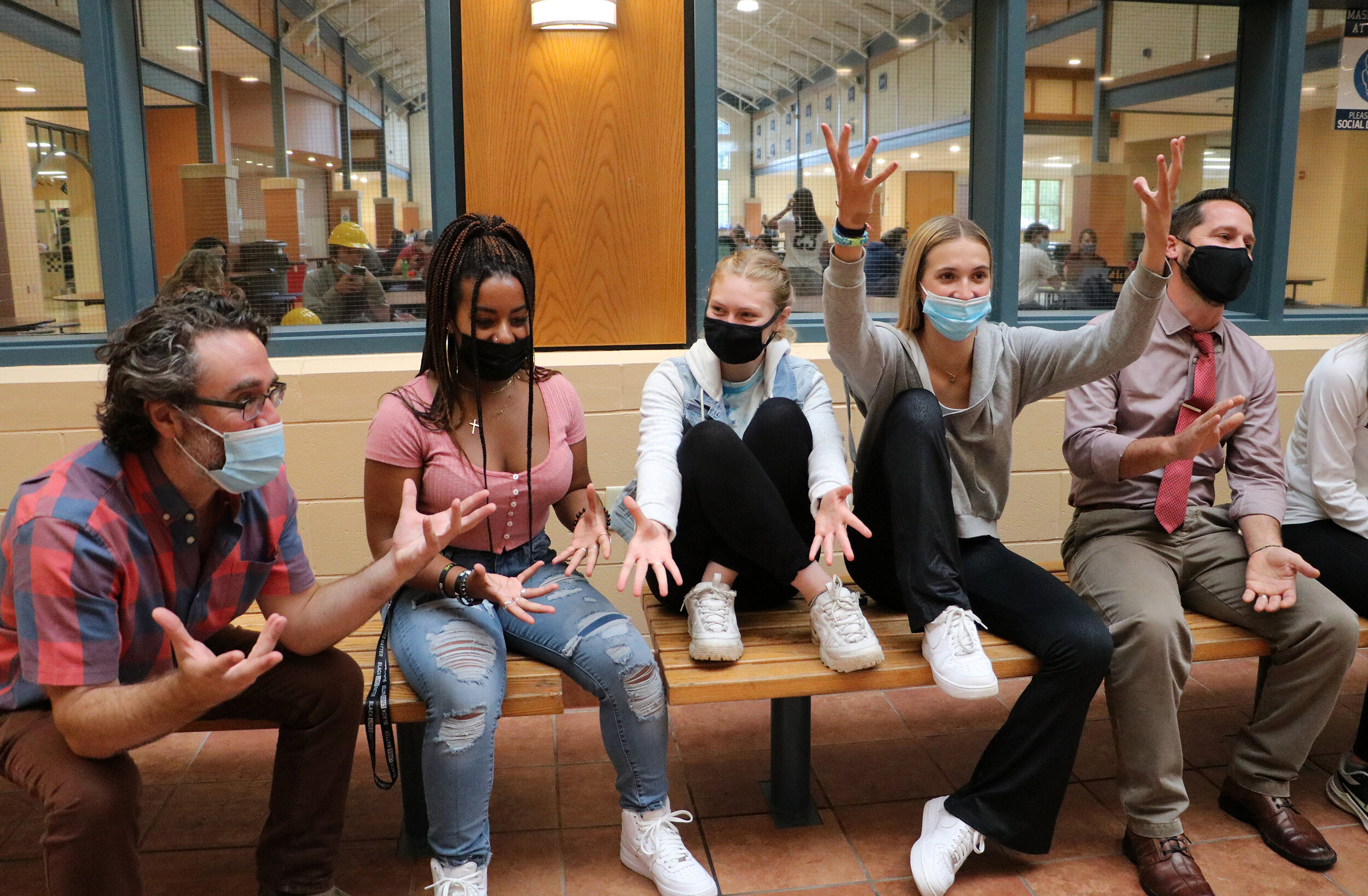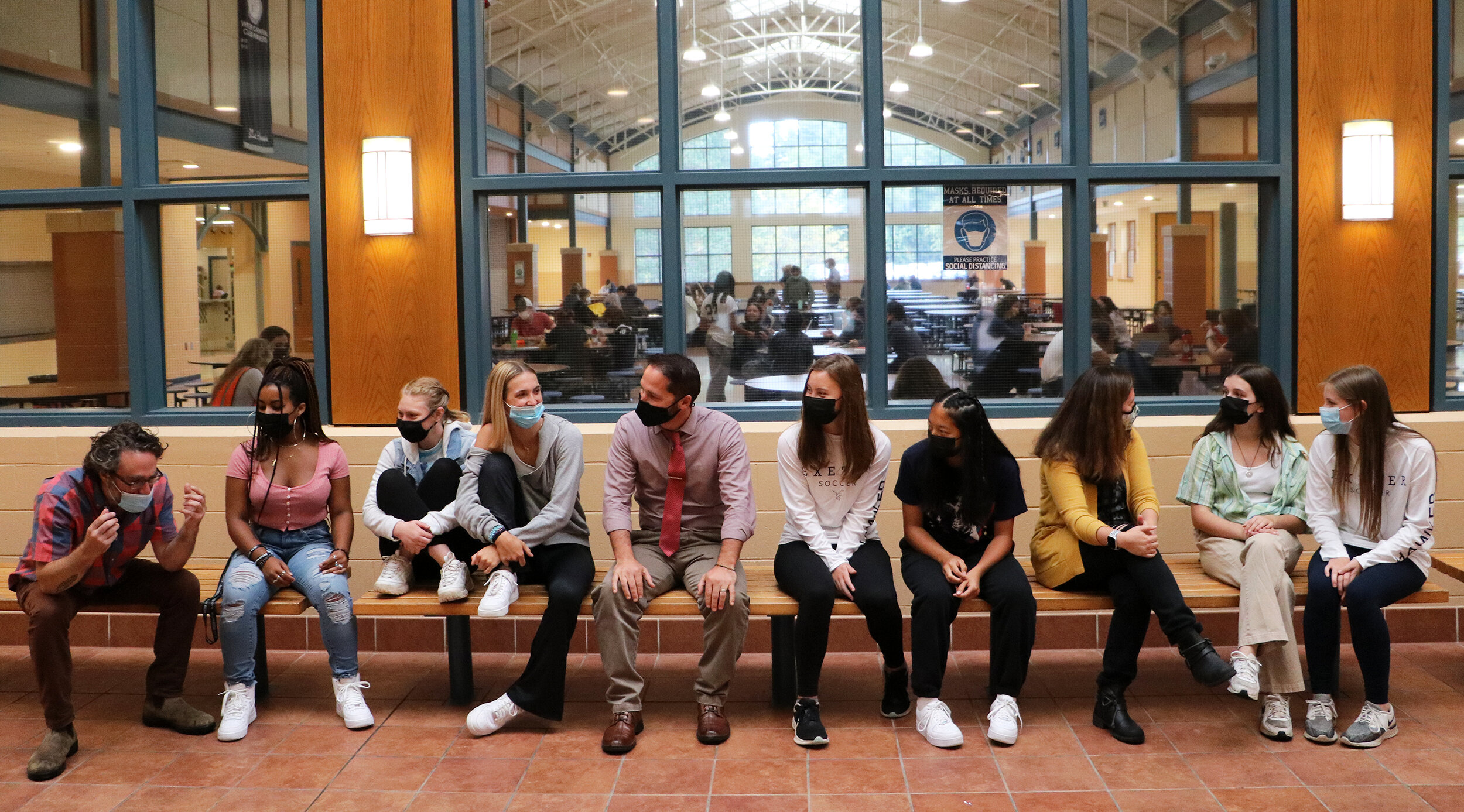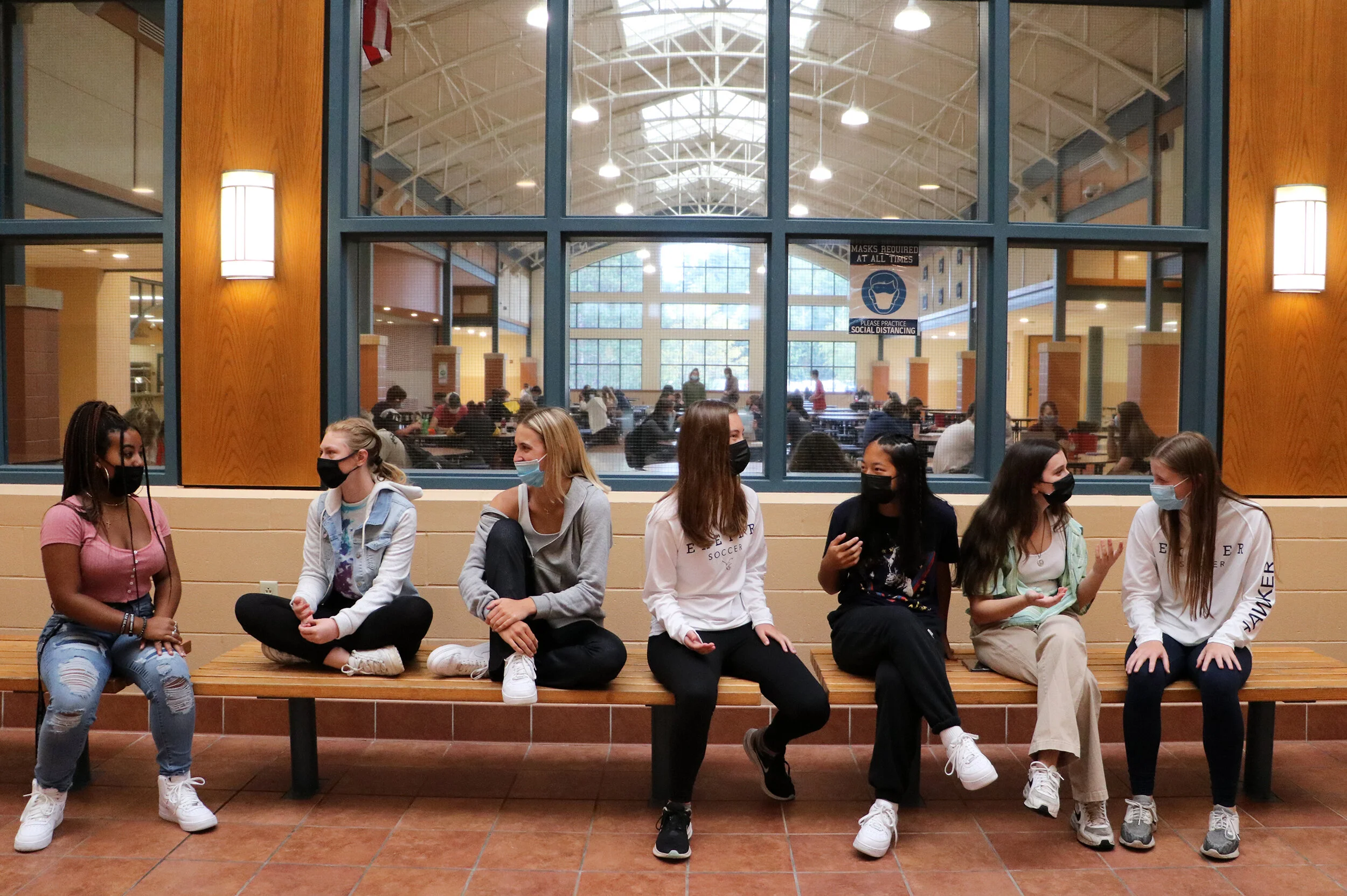Racial Unity Team, Exeter High join forces on collaborative spoken word and music project



Photos by Allegra Boverman
By Meg McIntyre, Granite State News Collaborative
Exeter Region Cooperative District is slightly less diverse and more wealthy than the state as a whole.
According to the New Hampshire Department of Education, in 2020-21, about 91% of students were non-Hispanic white, while nearly 4% of students were Asian, 2.5% were Hispanic or Latino, about 1.4% were multi-racial and about .8% were Black. About 4.2% of students at Exeter High were eligible to receive free and reduced lunch.
How do you teach and show diversity in a place where it doesn’t really exist? That, in part, became the mission of Exeter's Racial Unity Team, which formed about six years ago to focus on education.
"We knew we had to reach the children in our community," said Chair and Founding Member Ken Mendis. "New Hampshire being almost 90% white, children after they finish high school go out to colleges in other communities and other states, and they're really not prepared" to be in a more diverse environment.
The nonprofit racial justice organization wanted to bring a wider range of voices and perspectives into the schools for the benefit of all students, Mendis said — both for white students, who may not be exposed to diverse ideas or experiences, and for students of color, who don't often have role models who look like them at the front of the classroom.
The lack of diversity in a school or district can be isolating for some learners, while others may struggle to understand their peers or even see them as outsiders. In 2018-19, the New Hampshire Department of Education received 2,152 reports of bullying, of which 976 were investigated and determined to be "actual" cases of bullying. About 8% of those cases were based on a student's race, color or national origin, while about 7.5% were based on sexual orientation, 4.6% were related to gender and nearly 4% were related to a disability.
To get students thinking about issues of diversity and justice, the Racial Unity Team partnered with Exeter High to launch "Arts in Action: Spoken Word and Song Writing for Social Change,” a project connecting virtual artists-in-residence with Granite State students to encourage them to imagine a "future without racism."
Photo by Allegra Boverman
To Kill a Mockingbird Refresher
In Harper Lee's Pulitzer-winning coming-of-age novel "To Kill a Mockingbird," young tomboy Scout Finch is forced to rethink her ideas of "good" and "evil" when her father, an attorney, defends a Black man falsely accused of rape.
The book, which has been read in English classrooms across the country for decades, has been criticized as a "white savior" narrative that gives too much weight to white perspectives and doesn't explore race and racism deeply enough. Dimitry Anselme, executive director of program delivery for Facing History and Ourselves, agrees that "Mockingbird" has its limitations, but said that if taught well, it can be students' first introduction to discussing difficult topics.
"It's a rung in the ladder of joining these hard conversations that all of us are having," Anselme explained. "It's how to begin. And that's OK — it doesn't have to be a perfect tool."
Important Characters:
Scout Finch: The narrator of the novel. A tomboy with a sharp mind and a stubborn streak.
Jem Finch: Scout's protector and older brother by four years.
Tom Robinson: A Black field hand falsely accused of raping a white woman.
Atticus Finch: Father to Scout and Jem, lawyer, and prominent local citizen. Advocate for racial equality and defense attorney for Tom Robinson.
Calpurnia: The cook employed by the Finch family. A Black woman, Calpurnia provides one of the children's only connections to the Black community.
Boo Radley: A recluse who lives near the Finch family.
A new perspective on a classic
When Mendis approached Exeter educators about participating in the project, they saw it as an opportunity to weave together different aspects of their curriculum in a new way.
Previously, ninth graders went through separate units focused on spoken word poetry, Harper Lee's "To Kill a Mockingbird" and research and editorial writing. But those units never really "talked to each other," teacher Dennis Magliozzi said. Adding in the Racial Unity Team mentors and restructuring the semester made everything work in tandem.
English teacher Kristina Peterson said she and Magliozzi grappled with teaching "Mockingbird" for a while, recognizing its limitations in telling the story through the eyes of a white woman. This year, they flipped their approach to teaching the book in an attempt to "take it off its pedestal and really look underneath all of it," and taught it early in the semester rather than at the end.
"Instead of it just being a narrative about Scout, or Atticus, more this idea of, who are the voices that are not being centered, just not even being shown?" Peterson said. "And how can we bring those voices to light?"
Brookline, Massachusetts, nonprofit Facing History and Ourselves, which creates resources to help educators address hate in the classroom, suggests a similar framing in its guide to teaching "Mockingbird." Executive Director for Program Delivery Dimitry Anselme said when taught thoughtfully, the book can be an entry point for discussions not only about race, but about gender, sexuality and justice more broadly.
Those conversations don't necessarily need to result in a full-blown project like Exeter’s — as long as the dialogue encourages students to think critically and reflect on their own viewpoint and experiences, according to Anselme.
"It is a book that allows students to think about their own adolescent development and the moral and ethical development of adolescents, because that's what we see in Jem and Scout — how they grow and how they begin to think about what is right and what is wrong and justice over time," Anselme said.
The Exeter students' discussions of the book and its themes informed the rest of the semester's work. Then the English department joined forces with the social studies department to plan parallel units around the same motifs, allowing students to pursue the same research topic in both classes.
Educators and students agreed that collaborating with professional artists and mentors selected by the Racial Unity Team was the creative catalyst of the experience. Four mentors — musician and Exeter alumnus Doug Holzapfel, songwriter and storyteller Reggie Harris, Phillips Exeter Academy educator Courtney Marshall and musician Kevin Writer — participated in a Zoom Q&A session and created videos to share with the students discussing their thoughts around creativity, equity and advocacy.
"While they weren't all speaking about the text or specifically 'Mockingbird,' they were adding another layer of voices, perspectives, ideas about art in the world, which then led our students to express themselves," Magliozzi said. " … Whereas before, ultimately Harper Lee was the only one who had a voice on the stage."
The semester culminated in a broadcast on Creative Mornings Portsmouth, a local chapter of the international breakfast lecture series, where students shared what they learned about change and justice through poems, editorials, presentations and songs.
Student voices channeled for change, justice
Two of the students worked together to advocate for a change to the school's sports dress code, which requires girls who play field hockey to wear skirts. Others delved into farm-to-table philosophy and community supported agriculture (CSAs), the constitutionality of the Pledge of Allegiance and the concept of "cancel culture."
Another student, Ingrid Janicki, wrote a research paper highlighting the need for a more diverse English curriculum without tokenizing people of color, and created a reference list of books for teachers. The Racial Unity Team is now taking up the mantle of her project, Bookshelf Diversity, by offering funding to help selected educators expand their classroom libraries.
According to the former ninth-graders, watching and listening to their classmates' projects was just as interesting as completing their own.
"Talking about really heavy topics that came up in the book and come up now in everyday life … helped us come together and kind of think about it as a group of how we as teenagers can help with this problem," said Camryn Herrick, whose project focused on suicide prevention.
Every student's project was unique, noted student Zoe O'Kane, and that exposed her and her classmates to subjects and ideas that might not be talked about in their own families. O’Kane's research explored race as a social construct and its lack of scientific basis.
"If we talk about [things like] this more in school, like we did in this project, then that provides more of an ecosystem for students who haven't had a chance to talk about stuff like this before, to develop a point of view and from different perspectives," O'Kane said.
Part of what made the unit so engaging was how much it connected to the real world, student Annie Gorman said. She completed research on mental health awareness and wrote a song titled "Master in Disguise" that was featured in the Creative Mornings broadcast.
"It wasn't centered around learning something and then taking a test. I felt like I was learning something that could really help me change the world around me," Gorman said. " … Before, not only was I not too aware of what I could do as a 15-year-old student for the issues that I want to talk about, but I also didn't know that my school, the classroom, was a place where that could happen."
For Mendis, that drives at the heart of the project's goal — to teach students how to use their voices.
"One of the things that struck me as very significant was when a student said, 'I'm from this little town in New Hampshire. Who wants to listen to me?' So when I heard that, I said that my job has to be to create a platform that you will be able to be heard," Mendis said. " … We're building their confidence, building their passion to do something."
The Racial Unity Team now plans to bring the initiative to other New Hampshire classrooms and is in the process of selecting its next school to partner with. Educators will have an opportunity to tailor the arts and mentorship aspect of the project to their curriculum and student population, Mendis said.
Exeter hopes to continue pursuing projects like this, and the English and social studies departments are already working together on more ways to collaborate in the future, according to Peterson and Magliozzi.
And the program's impact has reached outside the walls of the high school in more ways than one — after the Creative Mornings broadcast, several students were invited to share their projects at Exeter's Juneteenth celebration.
"Talk about authentic teaching. Like, this wasn't just authentic for the kids," Peterson said. " … This was very authentic for us and totally in control to do some incredible reframing of things."
About the Education and Equity project
Over the next few months, the Granite State News Collaborative and its partners will be taking an in-depth look at all aspects of education in New Hampshire as part of its race and equity reporting project. The coverage seeks to highlight what is working in New Hampshire and what isn’t, while exploring solutions to common problems.
We’re especially interested in your thoughts and ideas. That’s why we’re coupling our coverage with an outreach campaign to get feedback and insight directly from Granite Staters.
We have an initial survey for teachers, who will have the opportunity to join a closed Facebook group called Teachers Off the Record. Here teachers will be able to participate in confidential, guided conversations about teaching and learning in the Granite State. This will also be an opportunity for teachers to interact with local reporters and editors, and help guide the series. For students, we've developed an informal survey to gather ideas about what's working and what isn't in New Hampshire classrooms.


